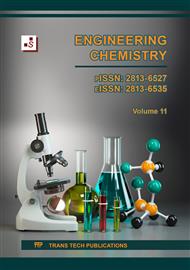p.1
p.7
p.25
p.39
p.53
p.63
Fabrication of Silica-Modified Green Mussel Shell-Based Chitosan Hydrogel Bio-Composite and Xanthan Gum from Tofu Dregs as Methylene Blue Photodegradator
Abstract:
Methylene Blue (MB) waste is damaging to both humans and the environment. Chitosan is one of the MB adsorbents that may be made from green mussel shells. Because CS compounds have a limited adsorption capacity for MB, a restricted surface area, and poor chemical stability, thus necessitating modification. CS/XG was created by combining the three chemicals silica (SiO2), tofu pulp, and the anionic substance Xanthan Gum (XG). SiO2 hydrogel bio-composite with the aid of UV light, can absorb MB by photodegradation. The objective of this paper is to analyze the regeneration and photocatalysis kinetics based on the kinetic rate constant of the bio-composite photodegradation, and to identify the ideal circumstances of MB photodegradation by CS/XG.SiO2 hydrogel bio-composite with Box-Behnken design. The CS/XG bio-composite was synthesized from chitosan (green mussel shell waste) and xanthan gum (tofu dregs waste) with added SiO2 to adsorb methylene blue via photodegradation. The use of green mussel shells and tofu dregs is significant as it turns abundant waste into valuable materials, reducing pollution and supporting low-cost, eco-friendly wastewater treatment.The variables were pH, MB concentration, and photodegradation time. The results showed that the optimum condition occurred at pH 9.43; MB concentration 5.054 ppm; and irradiation time 119.67 minutes with % degradation of 94.2%. After the 5th reuse of CS/XG.SiO2, the % degradation only decreased from 94.2% to 79.4%, indicating good regeneration ability. Analysis of photodegradation kinetics showed accurate modelling using the Modified Elovich model with an R2 value of 0.9805 and a photodegradation kinetic rate constant of 0.0010 min-1.
Info:
Periodical:
Pages:
25-38
Citation:
Online since:
September 2025
Keywords:
Permissions:
Share:
Citation:


